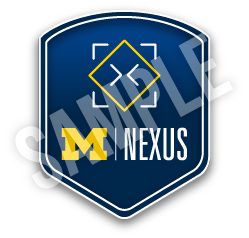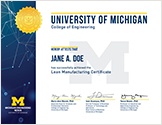PROFESSIONAL EDUCATION CERTIFICATES
Human Factors Engineering
Home » Professional Education » Human Factors Engineering
Key Information
Course Dates
Time Commitment
1-2 weeksNot ready to commit?
Subscribe for email updates on future offerings and get a program brochure.
HUMAN FACTORS ENGINEERING
Submit info below and we’ll email you our Human Factors course brochure.
By submitting this form, you are consenting to receive marketing emails from Nexus. You may unsubscribe at any time.
By clicking 'Get Course Information' you are agreeing to receive emails from Nexus.
Design Systems, Products, and Services to Effectively Meet the User’s Needs.
Human factors engineering concepts apply to almost any situation where a person is using a system, product, or service. With this hands-on, multidisciplinary training program—now in its 65th year—you can gain essential design experience and learn how to solve a wide range of human factors engineering and ergonomics problems. Identify potential and implement user testing to improve your product. Through more than 30 lectures, interactive workshops, seminars, tours, and more, you can gain a comprehensive and detailed description of models, theories, and data that you can apply to your work.
Early registrants can take advantage of special discount prices with these codes. On the day you register, enter the appropriate discount code to save.
Sign up:
- between 1/1/24 and 4/29/24 with the code HFE20 to save 20%
- between 4/30/24 and 5/28/24 with the code HFE15 to save 15%
- between 5/29/24 and 6/26/24 with the code HFE10 to save 10%
Click for details.
HUMAN FACTORS ENGINEERING
Submit info below and we’ll email you our Human Factors course brochure.
By submitting this form, you are consenting to receive marketing emails from Nexus. You may unsubscribe at any time.
By clicking 'Get Course Information' you are agreeing to receive emails from Nexus.
LEARNING OBJECTIVES
- Identify the human factors/ergonomics problems attendees face. Work through solutions from industries focused on a variety of outputs, including medical devices, aerospace, technology, and more.
- Apply the science of human factors —principles, equations, and models—to solve practical problems.
- Accept processes—design and test methods—to improve safety, system, and human performance.
- Find and use human factors data relevant to practical problems related to anthropometry, task times, human error, biomechanics, and many other topics.
- Learn to access relevant books, journal articles, conference papers, websites, design standards, and other information pertaining to each course topic.
PROGRAM OVERVIEW
LAPTOP REQUIRED FOR IN-PERSON OFFERINGS
week 1
The first week of the course focuses on human factors concepts, offering a broad survey of human factors topics important to researchers, designers, and manufacturers in a variety of work environments.
Monday 8:00 AM-6:00 PM
- What is the history of HFE and how has it evolved?
- What names are used to identify what we do?
- What does human factors matter?
- What does human factors have in common with other fields of endeavor?
- What do human factors specialists do?
- What societies are associated with human factors work?
- What are some primary journals and standards for our profession?
- How is light measured?
- What are the optical components of the eye?
- How do we see color?
- Rods and cones: the 8 elements of duplicity theory
- Eye movements and what they mean
- Failures of vision
- Why are visual displays important?
- What makes visual displays easy to use?
- When should auditory and visual displays be used?
- What kinds of visual displays are there?
- Which kinds of displays are best for various tasks?
- How should displays be arranged?
- What are desired characteristics for individual displays?
- What are the costs and benefits of color in displays?
- How should maps and spatial displays be designed (including size and clutter)?
- How should supervisory displays be designed?
- What do we know about information visualization?
- How should head mounted displays be designed?
- What do we know about virtual reality displays?
Tuesday 8:30 AM-9:15 PM
- Traditional techniques for measuring human body size, strength, and range of motion
- 3D and other techniques
- Analysis of anthropometric data (human variation, sampling, statistics)
- Databases and software for human accommodation
- Fitts’s Law and the control of discrete movements to small targets
- Models and theories of continuous tracking
- Rhythmic pattern generation
- How can controls be categorized and what are some examples?
- What should be considered when selecting controls?
- Which control is best and for what?
- How should individual controls be coded?
- Why are mice often best for desktop work?
- Are there better keyboards than QWERTY?
- Which widget is best for various tasks?
- What kinds of controls do people prefer?
- How should user performance with controls be measured?
Wednesday 8:30 AM-6:00 PM
- What kinds of musculoskeletal disorders occur?
- How can ergonomics prevent them?
- What are the occupational biomechanics of the spine, shoulder, elbow, and hand/wrist?
- How does one use the Washington State job analysis tool?
- What are some common job analysis tools (checklists, lifting analysis, computer models, field instrumentation, guidelines for tool selection)?
- Interventions to reduce injuries
- The economics of ergonomics
- What is situation awareness?
- What theory supports this concept?
- What are the design requirements for situation awareness?
- What are design principles for situation awareness?
- How is situation awareness measured?
Thursday 8:30 AM-9:30 PM
- What is the DOD development process?
- What is human-system integration?
- What are the steps in the Human-Systems Integration process?
- What tools are available to support Human-Systems Integration?
- What are some important performance measures?
- Time study
- Activity sampling
- Predetermined time systems
- Key references
Friday 8:30 AM-6:00 PM
- What are some lessons from the USS Vincennes incident?
- What are the stages of human information processing, and how do they affect comprehension?
- What is selective attention and how does it work?
- How do we support human performance?
- What are some models of human decision making?
- What are some common biases (fixation/anchoring, confirmation, salience/availability, overconfidence, framing) and how do they affect decision making?
- What is hierarchical task analysis?
- What are the approaches to safety?
- What are the causes and consequences of potential errors?
- Models of mishaps
- Root cause analysis
- Human error in healthcare surgical errors
Saturday Morning 8:30 AM-12:00 PM
- What research design is appropriate for various questions?
- What measures should be considered?
- What statistical analysis techniques are available?
- What guidelines should be followed for the treatment of human subjects?
- How does aging affect human performance?
- What is a disability and how does one comply with federal regulations such as ADA and Section 508 of the Rehabilitation Act?
- What is inclusive design and how is it accomplished?
- What are good design principles for older adults?
week 2
Human-computer interaction (HCI) and intelligent system design are the focus for week two, providing an overview of these issues through workshops that lay the foundation for effective intelligent systems. This is the future of all systems.
Monday 8:30 AM -6:00 PM
- What does HCI study?
- What are the people, tasks, and technology trends?
- How does innovation occur?
- What are the display trends?
- Location and activity aware computing
- What is computer-supported cooperative work?
- What is the intellectual framework for this topic?
- What are some applications?
- What are some key research findings?
- Who uses the web, and who are the users?
- What hardware and software do people use to access the web?
- Which sites are visited most often and what do people do? (Tasks)
- What are some web-specific design problems and how can they be solved?
- How should websites be designed?
- How can websites be automatically evaluated?
- How is use of the web likely to change in the future?
- What are some useful resources?
- What are the steps in conducting a usability test?
- At each step, what should one do and not do?
- What are some key references on usability testing?
Tuesday 8:30 AM-8:00 PM
- Why model user performance?
- What are the elements in the Keystroke-Level Model?
- How can task times be predicted using KLM?
Note: Students will compute the solutions to KLM problems in class
- What are the elements in the Model Human Processor?
- How can task times be predicted using the Model Human Processor?
Note: Students will compute the solutions to Model Human Processor problems in class
- Prescriptivism
- Agile development
- Task-centered design
Wednesday 8:30 AM-6:00 PM
- Heuristic evaluation
- Cognitive walkthrough
- Thinking aloud
- Real world testing
- User-centered design
- What is usability worth?
- Hypothetical case study
- Metrics for cost-benefit
- Calculating ROI
- Horror studies
- How is sound measured?
- When and why should speech interfaces be used?
- Who are the users of speech interfaces?
- What are the key terms used to describe dialogs?
- How is speech interface performance measured?
- How can user performance with speech interfaces be modeled and predicted?
- What are some accepted speech dialog design guidelines?
- How do you define and document requirements in the engineering design process?
- What are the applications?
Thursday 8:30 AM-6:00 PM
- Why automate?
- What are the levels of automation?
- What are the problems of automation?
- What are the ironies of automation?
- 5 principles of human-centered design
- What is workload?
- Why measure workload?
- How can workload be measured?
- How can workload be analyzed?
- How can workload be reduced?
- Where is there more information on workload?
Friday 8:30 AM-12:00 PM
- Heat
- Vibration and motion
- Sound and noise
- For yourself
- For your organization/employer
- How do you get human factors work done?
- Why is getting human factors work done so difficult?
sample lecture videos
🎦 GOMS and the Keystroke-Level Model
Dr. Paul Green | Human Factors Engineering Program Leader, University of Michigan
WHO SHOULD ATTEND
Engineers, psychologists, medical professionals, managers, and others interested in human factors, ergonomics, human-computer interaction, or usability. Attendees often work in industry, government, or the military.
- Human factors specialist
- Human factors engineer
- Human factors psychologist
- Engineering psychologist
- Usability engineer
- User experience engineer
- Usability analyst
- Ergonomist
- Ergonomics engineer
- Safety engineer
- Forensic expert
- Training needs analyst
- Systems Integration engineer
- Occupational therapist
SUPPLEMENTAL MATERIAL
IN PARTNERSHIP WITH NIST
INSTRUCTIONAL TEAM

PAUL GREEN, PHD
- Lead Faculty
- Research Professor, University of Michigan Transportation Research Institute
- Research Professor, Industrial & Operations Engineering
Dr. Paul Green teaches automotive human factors and human-computer interaction classes at the University of Michigan. A leader of U-M’s Human Factors Engineering Short Course for twenty-seven years, he is also the past president of the Human Factors and Ergonomics Society. Dr. Green leads a research team that focuses on driver distraction, driver workload, and workload managers, navigation system design, and motor-vehicle controls and displays.

Anhong Guo, PhD
- Assistant Professor, Computer Science & Engineering
- Assistant Professor of Information, School of Information

Richard Hughes, PhD
- Associate Professor, Biomedical Engineering and Industrial Operations Engineering, Orthopedic Surgery
- Director, Laboratory for Optimization and Computation in Orthopaedic Surgery

Sarah Parker, PhD
- Research Associate Professor, Fralin Biomedical Research Institute at VTC

F. Jacob Seagull, PhD
- Research Specialist Lead, Center for Bioethics and Social Sciences in Medicine (CBSSM)

Sheryl Ulin, PhD
- Research Program Officer, Center for Ergonomics
- Director of Continuing Education, Center for Occupational Health and Safety Engineering
What's Next?
CERTIFICATE
Design Thinking
Inspire organizational change with creative problem solving and strategic action.








